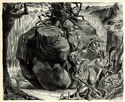
19th, 20th & 21st Century Fine Prints
707-546-7352 · fax 707-546-7924 · web: www.annexgalleries.com · email: artannex@aol.com
Angel Bracho Biography
Angel Bracho
Mexican
1911–2005
Biography
Painter and printmaker Angel Bracho was born on February 14, 1911, in Mexico City, Mexico. Born to a military captain and a farmworker, his family was poor and could not afford to send him to secondary school, and his primary schooling was cut short in order to earn a living. This would leave a lasting impression on him and his work would later focus on themes of social struggle.
Bracho worked a variety of odd jobs after leaving school as a teenager, including as a bus driver and haircutter, to help support his family. In 1928, the Escuela Nacional de Artes Plasticas began offering night classes to workers and he enrolled in courses taught by Diego Rivera and Rufino Tamayo. He would eventually become a full time student and graduate in 1934. He then worked alongside established artists Pablo O'Higgins and Leopoldo Mendez to create murals for the Abelardo L. Rodriguez market in Mexico City in 1935; this led to other commissions for the city and various institutions, including the Federacion Sindical and the Puebla teacher's college. In 1936 he joined the Liga de Escritores y Artistas Revolucionarios (League of Revolutionary Writers and Artists) and helped to co-found the Taller de Graphica Popular. In these enviornments Bracho began to explore themes of political, social, and economic injustice and created several collaborative works denouncing the rise of fascism in Europe and elsewhere with his cohorts, including O'Higgins, Rivera, Mendez, and several other leading Mexico City printmakers. It was at this time that the signature style of the TGP was established, taking up where Jose Guadalupe Posada had left off in referencing the folklore of traditional Mexican and Indigenous cultures to give voice to the working class. Bracho would remain an active and leading member of the TGP for fifty years.
Beginning in 1936 he took up a teaching position for the Secretary of Public Education, who sent artists, writers, and musicians to rural towns to educate local children, including in Oaxaca, Sinaloa, and Baja California. Eventually he would expand his teaching career into public schools in Mexico City, and in 1945 he became an advisor to the government in creating art programs in primary schools, a position he maintained for several decades.
Among the works he was known for were his portfolios of linoleum engravings dedicated to the everyday lives and accomplishments of the Mexican working class, and in the early 1940s he created a series capturing his time living with the Huichol Indigenous people, titled Ritual de la tribu India Huichol (Ritual of the Huichol Indian Tribe), published in 1945. He began working in lithography around this time and in 1947 his works were included in the Estampas de la Revolucion Mexicana catalogue. He also contributed several works to Futuro magazine (a publication of the Confederacion de Trabajadores de Mexico). He would later contribute written works to a variety of political publications including Massachusetts Review.
Bracho would become recognized as one of Mexico's leading printmakers, and he exhibited throughout Mexico as well as internationally, participating in shows in France, Russia, Italy, and South America. He was awarded a gold medal by Argentina's Vision magazine and first place in a contest organized by the Secrataria de Recursos Hidraulicos. He received an honprary professorship at the Academy of Design and Engraving in Florence, Italy, and was awarded a prize for his engraving there. Retrospectives of his work were held at the Michoacan Casa de la Cultura in 1970; the Mexico City Asemblea Legislative del Distrito Federal in 1992; and a posthumous exhibition held by the Instituto Nacional de Bellas Artes in collaboration with the TGP in 2005, among others.
Angel Bracho, nicknamed "the artist of the people," died in Mexico City on February 1, 2005.

